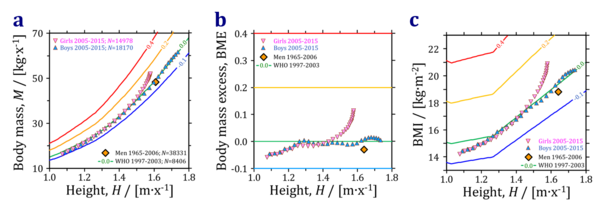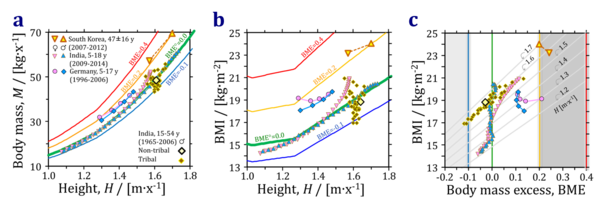Difference between revisions of "Indian Academy of Pediatrics Growth Charts Committee 2015 Indian Pediatr"
| Line 28: | Line 28: | ||
{{References: BME and height}} | |||
{{ | |||
[[Category:BME and mitObesity]] | [[Category:BME and mitObesity]] | ||
Revision as of 10:34, 6 February 2020
| Indian Academy of Pediatrics Growth Charts Committee, Khadilkar V, Yadav S, Agrawal KK, Tamboli S, Banerjee M, Cherian A, Goyal JP, Khadilkar A, Kumaravel V, Mohan V, Narayanappa D, Ray I, Yewale V (2015) Revised IAP growth charts for height, weight and body mass index for 5- to 18-year-old Indian children. Indian Pediatr 52:47-55. |
Indian Academy of Pediatrics Growth Charts Committee, Khadilkar V, Yadav S, Agrawal KK, Tamboli S, Banerjee M, Cherian A, Goyal JP, Khadilkar A, Kumaravel V, Mohan V, Narayanappa D, Ray I, Yewale V (2015) Indian Pediatr
Abstract: JUSTIFICATION: The need to revise Indian Academy of Pediatrics (IAP) growth charts for 5- to 18-year-old Indian children and adolescents was felt as India is in nutrition transition and previous IAP charts are based on data which are over two decades old.
PROCESS: The Growth Chart Committee was formed by IAP in January 2014 to design revised growth charts. Consultative meeting was held in November 2014 in Mumbai. Studies performed on Indian children's growth, nutritional assessment and anthropometry from upper and middle socioeconomic classes in last decade were identified. Committee contacted 13 study groups; total number of children in the age group of 5 to 18 years were 87022 (54086 boys). Data from fourteen cities (Agartala, Ahmadabad, Chandigarh, Chennai, Delhi, Hyderabad, Kochi, Kolkata, Madurai, Mumbai, Mysore, Pune, Raipur and Surat) in India were collated. Data of children with weight for height Z scores >2 SD were removed from analyses. Data on 33148 children (18170 males, 14978 females) were used to construct growth charts using Cole's LMS method.
OBJECTIVE: To construct revised IAP growth charts for 5-18 year old Indian children based on collated national data from published studies performed on apparently healthy children and adolescents in the last 10 years.
RECOMMENDATIONS: The IAP growth chart committee recommends these revised growth charts for height, weight and body mass index (BMI) for assessment of growth of 5-18 year old Indian children to replace the previous IAP charts; rest of the recommendations for monitoring height and weight remain as per the IAP guidelines published in 2007. To define overweight and obesity in children from 5-18 years of age, adult equivalent of 23 and 27 cut-offs presented in BMI charts may be used. IAP recommends use of WHO standards for growth assessment of children below 5 years of age.
• Bioblast editor: Gnaiger E
From BMI to BME
Work in progress by Gnaiger E 2020-02-05 linked to a preprint in preparation on BME and mitObesity.


- An increase of the BMI with height is a general feature of the healthy reference population (HRP) with reference body mass, M°, at a body mass excess, BME, of 0.0. The HRP is based on data for WHO Child Growth Standards (WHO Multicentre Growth Reference Study Group, WHO MGRS; WHO 2006 Acta Paediatr; WHO 2006 Geneva: World Health Organization) and the Committee on Biological Handbooks data set (CBH, Zucker 1962 Committee on Biological Handbooks, Fed Amer Soc Exp Biol), compiled from publications between 1931 to 1944 (USA). The average for adult men (India, non-tribal and tribal) and adult women and men from South Korea (Hood 2019 Nutr Diabetes) are shown for comparison (Fig. 1 and 2).
- The 50 centiles were used for height and body mass in each age group. BME and BMI were calculated from the 50 centiles. Calculated (from M and H) and originally published values of the BMI (50 centiles) are idential in girls and boys on average, but the published BMI increases in boys from 20.2 to 21.1 kg·m-2 for height of 1.696 to 1.736 m (M 58.2 to 61.6 kg; age 16.5 to 18 years), whereas the calculated BMI increases from 20.2 to 20.4 kg·m-2.
Publications: BME and height
| Reference | |
|---|---|
| Bosy-Westphal 2009 Br J Nutr | Bosy-Westphal A, Plachta-Danielzik S, Dörhöfer RP, Müller MJ (2009) Short stature and obesity: positive association in adults but inverse association in children and adolescents. Br J Nutr 102:453-61. |
| De Onis 2007 Bull World Health Organization | de Onis M, Onyango AW, Borghi E, Siyam A, Nishida C, Siekmann J (2007) Development of a WHO growth reference for school-aged children and adolescents. Bull World Health Organization 85:660-7. |
| Gnaiger 2019 MiP2019 | OXPHOS capacity in human muscle tissue and body mass excess – the MitoEAGLE mission towards an integrative database (Version 6; 2020-01-12). |
| Hood 2019 Nutr Diabetes | Hood K, Ashcraft J, Watts K, Hong S, Choi W, Heymsfield SB, Gautam RK, Thomas D (2019) Allometric scaling of weight to height and resulting body mass index thresholds in two Asian populations. Nutr Diabetes 9:2. doi: 10.1038/s41387-018-0068-3. |
| Indian Academy of Pediatrics Growth Charts Committee 2015 Indian Pediatr | Indian Academy of Pediatrics Growth Charts Committee, Khadilkar V, Yadav S, Agrawal KK, Tamboli S, Banerjee M, Cherian A, Goyal JP, Khadilkar A, Kumaravel V, Mohan V, Narayanappa D, Ray I, Yewale V (2015) Revised IAP growth charts for height, weight and body mass index for 5- to 18-year-old Indian children. Indian Pediatr 52:47-55. |
| Zucker 1962 Committee on Biological Handbooks, Fed Amer Soc Exp Biol | Zucker TF (1962) Regression of standing and sitting weights on body weight: man. In: Growth including reproduction and morphological development. Altman PL, Dittmer DS, eds: Committee on Biological Handbooks, Fed Amer Soc Exp Biol:336-7. |
Labels: MiParea: Gender, Exercise physiology;nutrition;life style
Pathology: Aging;senescence, Obesity
Organism: Human
Preparation: Intact organism
BMI, BME, Height

